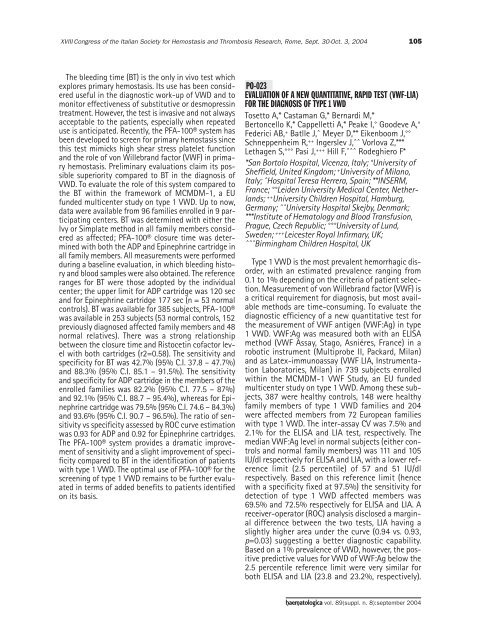Haematologica 2004;89: supplement no. 8 - Supplements ...
Haematologica 2004;89: supplement no. 8 - Supplements ...
Haematologica 2004;89: supplement no. 8 - Supplements ...
- No tags were found...
You also want an ePaper? Increase the reach of your titles
YUMPU automatically turns print PDFs into web optimized ePapers that Google loves.
XVIII Congress of the Italian Society for Hemostasis and Thrombosis Research, Rome, Sept. 30-Oct. 3, <strong>2004</strong>105The bleeding time (BT) is the only in vivo test whichexplores primary hemostasis. Its use has been considereduseful in the diag<strong>no</strong>stic work-up of VWD and tomonitor effectiveness of substitutive or desmopressintreatment. However, the test is invasive and <strong>no</strong>t alwaysacceptable to the patients, especially when repeateduse is anticipated. Recently, the PFA-100® system hasbeen developed to screen for primary hemostasis sincethis test mimicks high shear stress platelet functionand the role of von Willebrand factor (VWF) in primaryhemostasis. Preliminary evaluations claim its possiblesuperiority compared to BT in the diag<strong>no</strong>sis ofVWD. To evaluate the role of this system compared tothe BT within the framework of MCMDM-1, a EUfunded multicenter study on type 1 VWD. Up to <strong>no</strong>w,data were available from 96 families enrolled in 9 participatingcenters. BT was determined with either theIvy or Simplate method in all family members consideredas affected; PFA-100® closure time was determinedwith both the ADP and Epinephrine cartridge inall family members. All measurements were performedduring a baseline evaluation, in which bleeding historyand blood samples were also obtained. The referenceranges for BT were those adopted by the individualcenter; the upper limit for ADP cartridge was 120 secand for Epinephrine cartridge 177 sec (n = 53 <strong>no</strong>rmalcontrols). BT was available for 385 subjects, PFA-100®was available in 253 subjects (53 <strong>no</strong>rmal controls, 152previously diag<strong>no</strong>sed affected family members and 48<strong>no</strong>rmal relatives). There was a strong relationshipbetween the closure time and Ristocetin cofactor levelwith both cartridges (r2=0.58). The sensitivity andspecificity for BT was 42.7% (95% C.I. 37.8 – 47.7%)and 88.3% (95% C.I. 85.1 – 91.5%). The sensitivityand specificity for ADP cartridge in the members of theenrolled families was 82.2% (95% C.I. 77.5 – 87%)and 92.1% (95% C.I. 88.7 – 95.4%), whereas for Epinephrinecartridge was 79.5% (95% C.I. 74.6 – 84.3%)and 93.6% (95% C.I. 90.7 – 96.5%). The ratio of sensitivityvs specificity assessed by ROC curve estimationwas 0.93 for ADP and 0.92 for Epinephrine cartridges.The PFA-100® system provides a dramatic improvementof sensitivity and a slight improvement of specificitycompared to BT in the identification of patientswith type 1 VWD. The optimal use of PFA-100® for thescreening of type 1 VWD remains to be further evaluatedin terms of added benefits to patients identifiedon its basis.PO-023EVALUATION OF A NEW QUANTITATIVE, RAPID TEST (VWF-LIA)FOR THE DIAGNOSIS OF TYPE 1 VWDTosetto A,* Castaman G,* Bernardi M,*Bertoncello K,* Cappelletti A,* Peake I,° Goodeve A,°Federici AB, + Batlle J,^ Meyer D,** Eikenboom J,°°Schneppenheim R, ++ Ingerslev J,^^ Vorlova Z,***Lethagen S,°°° Pasi J, +++ Hill F,^^^ Rodeghiero F**San Bortolo Hospital, Vicenza, Italy; °University ofSheffield, United Kingdom; + University of Mila<strong>no</strong>,Italy; ^Hospital Teresa Herrera, Spain; **INSERM,France; °°Leiden University Medical Center, Netherlands;++ University Children Hospital, Hamburg,Germany; ^^University Hospital Skejby, Denmark;***Institute of Hematology and Blood Transfusion,Prague, Czech Republic; °°°University of Lund,Sweden; +++ Leicester Royal Infirmary, UK;^^^Birmingham Children Hospital, UKType 1 VWD is the most prevalent hemorrhagic disorder,with an estimated prevalence ranging from0.1 to 1% depending on the criteria of patient selection.Measurement of von Willebrand factor (VWF) isa critical requirement for diag<strong>no</strong>sis, but most availablemethods are time-consuming. To evaluate thediag<strong>no</strong>stic efficiency of a new quantitative test forthe measurement of VWF antigen (VWF:Ag) in type1 VWD. VWF:Ag was measured both with an ELISAmethod (VWF Assay, Stago, Asniéres, France) in arobotic instrument (Multiprobe II, Packard, Milan)and as Latex-immu<strong>no</strong>assay (VWF LIA, InstrumentationLaboratories, Milan) in 739 subjects enrolledwithin the MCMDM-1 VWF Study, an EU fundedmulticenter study on type 1 VWD. Among these subjects,387 were healthy controls, 148 were healthyfamily members of type 1 VWD families and 204were affected members from 72 European familieswith type 1 VWD. The inter-assay CV was 7.5% and2.1% for the ELISA and LIA test, respectively. Themedian VWF:Ag level in <strong>no</strong>rmal subjects (either controlsand <strong>no</strong>rmal family members) was 111 and 105IU/dl respectively for ELISA and LIA, with a lower referencelimit (2.5 percentile) of 57 and 51 IU/dlrespectively. Based on this reference limit (hencewith a specificity fixed at 97.5%) the sensitivity fordetection of type 1 VWD affected members was69.5% and 72.5% respectively for ELISA and LIA. Areceiver-operator (ROC) analysis disclosed a marginaldifference between the two tests, LIA having aslightly higher area under the curve (0.94 vs. 0.93,p=0.03) suggesting a better diag<strong>no</strong>stic capability.Based on a 1% prevalence of VWD, however, the positivepredictive values for VWD of VWF:Ag below the2.5 percentile reference limit were very similar forboth ELISA and LIA (23.8 and 23.2%, respectively).haematologica vol. <strong>89</strong>(suppl. n. 8):september <strong>2004</strong>
















